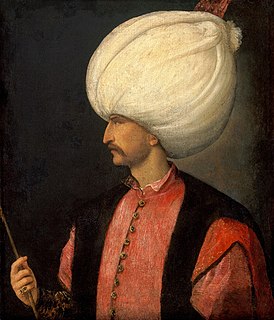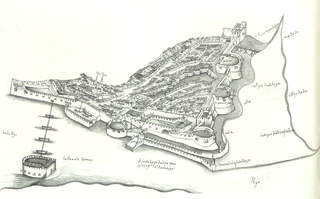
Ahmed Muhiddin Piri, better known as Piri Reis, was an Ottoman admiral, navigator, geographer and cartographer.

Suleiman I, commonly known as Suleiman the Magnificent in the West and Suleiman the Lawgiver in his realm, was the tenth and longest-reigning Sultan of the Ottoman Empire from 1520 until his death in 1566. Under his administration, the Ottoman caliphate ruled over at least 25 million people.
Murat Reis the Elder was an Ottoman privateer and admiral, who served in the Ottoman Navy. He is regarded as one of the most important Barbary corsairs.

Hayreddin Barbarossa, or Barbaros Kheireddin Pasha, born Khizr or Khidr, was an Ottoman corsair and later admiral of the Ottoman Navy. Barbarossa's naval victories secured Ottoman dominance over the Mediterranean during the mid 16th century.

The Ottoman Navy, also known as the Ottoman Fleet, was established in the early 14th century after the Ottoman Empire first expanded to reach the sea in 1323 by capturing Karamürsel, the site of the first Ottoman naval shipyard and the nucleus of the future Navy. During its long existence, it was involved in many conflicts and signed a number of maritime treaties. At its height, the Navy extended to the Indian Ocean, sending an expedition to Indonesia in 1565.
Kurtoğlu Muslihiddin Reis was a privateer and admiral of the Ottoman Empire, as well as the Sanjak Bey of Rhodes. He played an important role in the Ottoman conquests of Egypt (1517) and Rhodes (1522) during which he commanded the Ottoman naval forces. He also helped establish the Ottoman Indian Ocean Fleet based in Suez, which was later commanded by his son, Kurtoğlu Hızır Reis.
Kurtoğlu Hızır Reis was an Ottoman admiral who is best known for commanding the Ottoman naval expedition to Sumatra in Indonesia (1568–1569).
Seydi Ali Reis (1498–1563), formerly also written Sidi Ali Reis and Sidi Ali Ben Hossein, was an Ottoman admiral and navigator. Known also as Katib-i Rumi, Galatalı or Sidi Ali Çelebi, he commanded the left wing of the Ottoman fleet at the naval Battle of Preveza in 1538. He was later promoted to the rank of fleet admiral of the Ottoman fleet in the Indian Ocean, and as such, encountered the Portuguese forces based in the Indian city of Goa on several occasions in 1554.
Salah Rais was an Ottoman privateer and admiral. He is alternatively referred to as Sala Reis, Salih Rais, Salek Rais and Cale Arraez in several European sources, particularly in Spain, France and Italy.

The Ottoman-Portuguese conflicts of 1538 to 1559 were a series of armed military encounters between the Portuguese Empire, the Kingdom of Hormuz, and the Ethiopian Empire against the Ottoman Empire and Adal Sultanate, in the Indian Ocean, the Persian Gulf, the Red Sea, and in East Africa. This is a period of battles in The Ottoman-Portuguese War.

The Ottoman expeditions in the Indian Ocean were a series of Ottoman amphibious operations in the Indian Ocean in the 16th century. There were four expeditions between 1538 and 1554, during the reign of Suleiman the Magnificent.

The Ottoman expedition to Aceh started from around 1565 when the Ottoman Empire endeavoured to support the Aceh Sultanate in its fight against the Portuguese Empire in Malacca. The expedition followed an envoy sent by the Acehnese Sultan Alauddin Riayat Syah al-Kahhar (1539–71) to Suleiman the Magnificent in 1564, and possibly as early as 1562, requesting Ottoman support against the Portuguese.

The Siege of Diu occurred when an army of the Sultanate of Gujarat under Khadjar Safar, aided by forces of the Ottoman Empire, attempted to capture the city of Diu in 1538, then held by the Portuguese. The Portuguese successfully resisted the four months long siege. It is part of The Ottoman-Portuguese War.

The following outline is provided as an overview of and topical guide to the Ottoman Empire:

Selman Reis was an Ottoman admiral and former corsair who was active in the Mamluk Navy of Egypt and later in the Ottoman Navy against the Portuguese in the first half of the 16th century. Selman Reis was originally from the Aegean island of Lesbos.

Hadım Suleiman Pasha was an Ottoman statesman and military commander. He served as the viceroy of Ottoman Egypt in 1525–1535 and 1537–1538, and as Grand Vizier of the Ottoman Empire between 1541 and 1544. He was a Hungarian eunuch, his epithet hadım meaning "eunuch" in Turkish.

Dragut, known as "The Drawn Sword of Islam", was a Muslim Ottoman naval commander, governor, and noble, of Greek or Turkish descent. Under his command, the Ottoman Empire's maritime power was extended across North Africa. Recognized for his military genius, and as being among "the most dangerous" of corsairs, Dragut has been referred to as "the greatest pirate warrior of all time", "undoubtedly the most able of all the Turkish leaders", and "the uncrowned king of the Mediterranean". He was described by a French admiral as "A living chart of the Mediterranean, skillful enough on land to be compared to the finest generals of the time. No one was more worthy than he to bear the name of king".

The Capture of Muscat occurred in 1552, when an Ottoman fleet under Piri Reis attacked Old Muscat, in modern Oman, and plundered the town from the Portuguese. These events followed the important Ottoman defeat in the Second Siege of Diu in 1546, which put a stop to their attempts in India, but also the successful Capture of Aden (1548), which allowed the Ottomans to resist the Portuguese in the northwestern part of the Indian Ocean.

The Ottoman campaign against Hormuz took place in 1552–54. An Ottoman fleet led by Admiral Piri Reis and Seydi Ali Reis was dispatched from the Ottoman harbour of Suez to eliminate the Portuguese presence from the northwestern part of the Indian Ocean, and especially their fortress at Hormuz Island.

Ottoman wars in Asia refers to the wars involving the Ottoman Empire in Asia. Ottoman Empire was founded at the beginning of the 14th century. Its original settlement was in the north west Anatolia where it was a small beylik (principality). Its main rival was Byzantine Empire. In 1350s Ottomans were able to cross the Dardanelles strait and eventually they conquered whole south east Europe. Although they mainly concentrated on Europe, they also fought in Asia.














